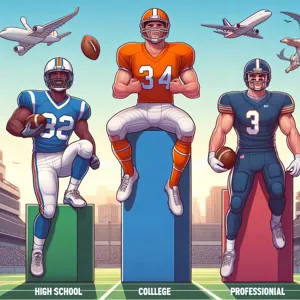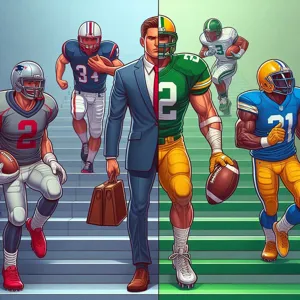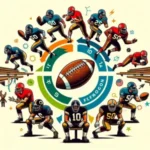American football is more than just a sport; it’s a vibrant tapestry woven into the cultural fabric of the United States.
From the electrifying atmosphere of high school games under the iconic Friday night lights to the grand spectacle of the NFL, each level of the game offers its own unique experience, challenges, and fervent fanbase. In this blog post, we’ll embark on a comparative journey through the various levels of American football, exploring the distinct characteristics that set them apart. We’ll delve into the passion and camaraderie of local high school teams, the competitive spirit of college football, and the sheer intensity of professional play in the NFL. Whether you’re a die-hard fan, a casual observer, or someone curious about the evolution of the sport, this exploration will illuminate the heart and soul of American football at every level. Join us as we uncover what makes each tier of the game special and how they collectively contribute to the rich legacy of this beloved American pastime.
1. Introduction to American Football Levels

American football is a vibrant tapestry of competition that weaves together communities, fosters camaraderie, and ignites passionate rivalries across the United States. From the humble beginnings of high school Friday night lights to the grand spectacle of the NFL Sunday showcase, the sport exists at multiple levels, each with its distinct culture, rules, and significance.
At the grassroots level, high school football serves as the foundation of American football, where young athletes begin to hone their skills and dreams of future stardom. These games are often the heartbeat of small towns, bringing together families and friends under the glow of stadium lights. The fervor of the crowd, the marching band’s anthems, and the spirited cheerleaders create an atmosphere that is electric, making Friday nights a cherished tradition.
As players progress, they move into college football, a level that not only elevates the competition but also introduces the excitement of national rankings and bowl games. College teams often boast large followings, with fans passionately supporting their alma maters. The NCAA landscape is rich with history and rivalries, and for many, it’s the stepping stone to professional careers.
Finally, the pinnacle of American football can be found in the NFL, where elite athletes compete at the highest level of skill and strategy. The NFL captures the imagination of millions, with its Super Bowl being one of the most-watched sporting events worldwide. The stakes are high, and the pressure is immense, as teams battle for glory in a league that showcases the best talent the game has to offer.
In this blog post, we will explore the distinct characteristics of each level of American football, examining how they interconnect and contribute to the overall fabric of the sport. From the camaraderie of high school teams to the intense competition of the professional league, each level plays a vital role in shaping the athletes, fans, and culture surrounding American football. Join us as we dive deeper into this exhilarating journey from the local fields to the NFL stadiums, highlighting the passion and dedication that defines this beloved game.
2. The High School Experience: Friday Night Lights
The high school football experience, often romantically dubbed “Friday Night Lights,” encapsulates a unique blend of passion, community spirit, and youthful ambition. As the sun sets on a crisp autumn evening, the air fills with the electric anticipation of a game under the stadium lights. Families, friends, and alumni gather in droves, donning team colors and filling the bleachers with a sea of enthusiasm. This communal gathering is more than just a sporting event; it’s a celebration of local pride and youthful dreams.
High school football stands out for its raw intensity. Players, often still in their teens, pour their hearts into the game, motivated by aspirations of glory and the desire to impress scouts. The field is not merely a place for competition; it serves as a proving ground where young athletes learn the value of teamwork, discipline, and resilience. Coaches, often revered figures in their communities, guide these impressionable players, instilling fundamental skills that will shape their athletic futures.
The experience is also deeply rooted in tradition. Each school boasts its own unique rituals, from spirited pep rallies to the playing of fight songs, creating an atmosphere steeped in local lore and camaraderie. Cheerleaders rally the crowd, while marching bands fill the air with spirited melodies, enhancing the excitement of each play. The stakes may seem lower than those in the NFL, but the emotions are just as high—every touchdown, fumble, and interception is met with cheers or gasps, as the entire community is invested in the outcome.
Beyond the field, high school football plays a significant role in shaping personal identities. For many players, these Friday nights are a rite of passage, marking their entry into adulthood and a harbinger of future opportunities. Scouting and recruitment can lead to collegiate football, and for some, a pathway to the NFL. Yet, even for those who don’t advance to the professional level, the lessons learned and friendships forged during these formative years remain invaluable, creating memories that last a lifetime.
In essence, the high school football experience is a microcosm of American culture—passionate, competitive, and communal. It lays the foundation for the sport, nurturing talent and fostering a love for the game that will resonate throughout a player’s life, whether they ascend to the NFL or cherish their Friday night memories long after the final whistle.
3. Transitioning from High School to College Football

Transitioning from high school to college football is a pivotal moment in an athlete’s career, marked by both excitement and significant challenges. For many young athletes, high school football serves as a launching pad, showcasing their skills on a localized stage where they often become stars among peers, friends, and family. However, the leap to college football introduces a new level of competition that can be both exhilarating and overwhelming.
In high school, players often dominate their positions, relying on sheer talent and physicality to stand out. But as they enter the college arena, they quickly realize that they are no longer the biggest fish in a small pond. College football demands not only exceptional athletic skills but also a deeper understanding of the game. Players must adapt to faster-paced play, new offensive and defensive schemes, and a higher level of physical conditioning. The speed of the game increases dramatically, and the margin for error shrinks, requiring athletes to sharpen their mental acuity along with their physical skills.
Moreover, the recruitment process can be daunting. High school athletes must navigate offers from various colleges, evaluate their fit within different programs, and often contend with intense competition for scholarships. It’s a time when personal commitment and hard work truly pay off, and relationships with coaches become crucial. Coaches at the college level are looking for players who not only possess talent but also demonstrate the potential for growth, discipline, and teamwork.
Once on campus, the adjustment period can be challenging. Balancing academics with a rigorous training schedule demands strong time management skills. College athletes must learn to juggle classes, study sessions, and practice while dealing with the pressures of maintaining scholarship eligibility. The camaraderie that develops on the field often extends off the field, as teammates become a support system in this new environment, helping each other navigate both the challenges of college life and the rigors of a demanding football program.
As athletes transition from high school to college football, they embark on a journey that tests their dedication, resilience, and passion for the game. Each step forward is a testament to their hard work, and for many, it is the beginning of a dream that could lead them to the highest levels of the sport, including the NFL. The experience is transformative, shaping not only their skills as players but also their character as individuals ready to face the challenges ahead.
4. The Role of NCAA Football in Player Development
NCAA football serves as a critical stepping stone for aspiring athletes on their journey to the NFL, playing an indispensable role in player development. At this collegiate level, young athletes hone their skills, both physically and mentally, in a highly competitive environment. The NCAA, comprising dozens of schools across various divisions, offers a diverse range of programs that emphasize not just athletic prowess, but also academic achievement and personal growth.
In the NCAA, players benefit from access to advanced coaching techniques, state-of-the-art training facilities, and a structured regimen that mirrors professional expectations. Coaches at this level are often former players or seasoned professionals who bring a wealth of knowledge and experience. They focus on refining players’ techniques, enhancing their understanding of the game, and instilling discipline and teamwork—qualities essential for success in the NFL.
Moreover, NCAA football provides athletes with the opportunity to compete against top-tier talent. This exposure is invaluable, as players learn to adapt to different playing styles and develop resilience in high-pressure situations. Games are often broadcasted nationally, offering players a platform to showcase their skills to NFL scouts and coaches who closely monitor their performance throughout the season.
The experience gained in the NCAA extends beyond the field; it equips players with critical life skills such as time management, leadership, and the ability to work collaboratively. The balance between academics and athletics fosters a sense of responsibility, preparing players for the rigors of professional football and life beyond the game.
Ultimately, NCAA football is more than just a precursor to the NFL; it is a formative experience that shapes the future of countless athletes. It is here that they not only refine their physical abilities but also cultivate the mental fortitude and character necessary to thrive at the next level. As these players transition to the NFL, they carry with them the lessons learned and the relationships forged during their collegiate years, making NCAA football an integral part of the American football ecosystem.
5. The Path to the NFL: Draft Process and Scouting

The journey from high school to the NFL is a complex path filled with rigorous evaluation, intense competition, and, ultimately, the thrill of the draft. For aspiring athletes, understanding the draft process and scouting is crucial, as it can make the difference between a dream realized and a career left on the sidelines.
As players transition from high school to college football, their performance on the field becomes the focal point of interest for scouts and recruiters. College teams are often scouted heavily, with the best players showcased in high-stakes games that attract numerous scouts from the NFL. This is where the evaluation begins in earnest; scouts assess a player’s physical abilities, understanding of the game, and potential for growth. Metrics such as speed, agility, strength, and technical skills are meticulously recorded, creating a comprehensive profile of each athlete.
Once players enter college, their exposure to the NFL draft process intensifies. They participate in combines, where they are put through a series of physical and mental tests. The NFL Scouting Combine, held annually, is a premier event that showcases the cream of the crop. Here, athletes undergo rigorous drills, interviews, and psychological evaluations, all designed to determine their readiness for the professional level. Performance in these combines can significantly impact a player’s draft stock, making it a pivotal moment in their career.
As the draft approaches, the scouting reports are compiled, and mock drafts begin circulating. NFL teams analyze the scouting data, assessing not only the player’s capabilities but also their fit within the team’s existing roster and system. Factors such as character, work ethic, and injury history also come into play, as teams seek to build a cohesive squad that can compete at the highest level.
The culmination of this extensive process occurs during the NFL Draft, a highly publicized event where teams select eligible players to join their ranks. The excitement is palpable as players gather in hopes of hearing their names called, marking the transition from amateur to professional. For many, this moment is a dream come true, the final validation of years of hard work and dedication.
Understanding this journey not only highlights the dedication required to reach the NFL but also showcases the rigorous processes involved in selecting talent at the professional level. From Friday night lights to the glitz and glamour of the draft, the path to the NFL is as challenging as it is rewarding, making each player’s story uniquely compelling in the landscape of American football.
6. Key Differences in Gameplay: High School vs. NFL
When it comes to American football, the thrill of the game can be felt at every level, from the spirited Friday night high school matches under the bright stadium lights to the electrifying atmosphere of the NFL. However, the differences in gameplay between these two levels are significant, impacting everything from strategy to player development.
In high school football, the game is often characterized by a raw, unpolished style of play. Players are typically still honing their skills, which can lead to a more chaotic and unpredictable game. Teams may rely heavily on simple plays and formations, often favoring a run-heavy offense that showcases the raw athleticism of their players. This is partly due to the varying levels of experience and skill among the athletes, as high school teams are often composed of a mix of seasoned players and those new to the sport. Moreover, high school football prioritizes community engagement and school spirit, making the emotional investment in each game palpable, as students, parents, and fans rally together to support their teams.
In contrast, the NFL represents the pinnacle of excellence in American football, where every player is among the best in the country. The gameplay is marked by a high level of sophistication and strategy, with teams employing complex schemes and formations designed by seasoned coaches. NFL offenses often feature intricate passing plays and a balanced mix of run and pass strategies, tailored to exploit opponents’ weaknesses. The speed and precision of the game are remarkable; where high school players might struggle with execution, NFL players demonstrate an extraordinary level of skill and athleticism, allowing them to perform at an incredibly high tempo.
Another key difference lies in the physicality of play. High school players, still developing physically and mentally, may not yet have the strength and conditioning of their NFL counterparts. The NFL game is not only faster but also more brutal, with players being bigger, stronger, and more prepared for the challenges of professional football. This increased physicality leads to different styles of tackling and blocking, with a focus on safety and technique that evolves as players advance through the ranks.
Finally, the stakes in the NFL are significantly higher, affecting the intensity and pressure of the game. In high school, victories are celebrated, but the outcomes don’t typically carry long-term consequences beyond local bragging rights or playoff positioning. In the NFL, each game contributes to the overall quest for the Super Bowl, with every play scrutinized and analyzed, and every decision made under immense pressure. This high-stakes environment shapes not only the gameplay but also the mindset of the players and coaches, fostering a culture of excellence that is palpable on the field.
In summary, while both high school and NFL games share the same fundamental rules and objectives, the differences in gameplay are stark. From the raw excitement of Friday nights to the polished, high-stakes battles of the NFL, each level of American football offers a unique experience that captures the hearts of fans across the nation.
7. Training Regimens Across Different Levels

Training regimens in American football can vary dramatically across different levels, each tailored to the unique demands and expectations of the athletes involved. At the high school level, particularly in programs inspired by the Friday Night Lights phenomenon, training typically focuses on building foundational skills and fostering teamwork. Coaches emphasize strength and conditioning, often incorporating multi-sport training to develop well-rounded athletes. Practices might be grueling yet spirited, filled with drills that hone specific techniques and strategies, all while instilling a sense of camaraderie among players.
As athletes transition to college football, the training regimens intensify significantly. At this level, players are not only honing their physical skills but also delving into advanced tactical understanding and game preparation. Strength and conditioning programs become more specialized, often overseen by professional trainers who develop tailored workout plans focusing on increasing strength, speed, and agility. College athletes typically engage in rigorous daily practices that may include film study sessions, weight training, and position-specific drills, all designed to prepare them for the demands of high-stakes games in front of large crowds.
When it comes to the NFL, the training regimen reaches a peak of professionalism and intensity. Players are now full-time athletes, often spending several hours a day in team facilities. Their schedules include a combination of strength training, cardiovascular workouts, skill drills, and tactical meetings with coaches. Nutrition and recovery play critical roles in their regimens, with many players working closely with dietitians and sports psychologists to optimize their performance. The competition is fierce, and every detail matters, from the precision of route running to the intricacies of defensive schemes.
In essence, while the passion for the game fuels athletes at every level, the approach to training evolves significantly from the grassroots of high school to the elite level of the NFL. Each stage not only builds on the last but also prepares players for the unique challenges they will face as they pursue their football dreams, whether they are under the bright lights of a Friday night game or battling it out on the professional stage.
8. The Importance of Coaching Styles and Strategies
Coaching styles and strategies play a pivotal role at every level of American football, shaping not just the performance of individual players, but also the overall dynamics of the team. From the high school fields lit by Friday night lights to the grand stadiums of the NFL, the approach a coach takes can significantly influence a team’s success and player development.
At the high school level, coaching often revolves around nurturing young talent and instilling fundamental skills. Coaches are tasked with teaching the basics of the game, emphasizing teamwork, discipline, and sportsmanship. They often employ a variety of engaging drills and techniques to maintain players’ interest and build their confidence. This is a formative time for athletes, where the coach’s ability to inspire and motivate can set the foundation for future success, both on and off the field. The personal touch in coaching at this level allows for deeper connections, as coaches frequently become mentors who guide players through not only the rigors of the sport but also the challenges of adolescence.
As players transition to college football, coaching styles become more complex and strategic. Coaches must not only refine players’ technical skills but also implement advanced game strategies that align with their team’s strengths and weaknesses. This is where the influence of analytics and data-driven decision-making begins to take center stage. Coaches use film analysis and statistical models to devise game plans that exploit opponents’ vulnerabilities while maximizing their own players’ abilities. The competitive nature of college football demands a higher level of strategy, leading to a focus on specialized training and preparation.
In stark contrast, the NFL demands a different breed of coaching. Here, the stakes are higher, and the margins for error slimmer. Coaches are tasked with managing a roster of elite athletes, each with their own strengths, weaknesses, and personalities. The ability to adapt strategies in real-time during games is paramount, as NFL coaches must think several steps ahead of their opponents. They employ intricate playbooks filled with complex formations and schemes, often relying on a combination of instinct, experience, and real-time analytics to make split-second decisions. Leadership takes on a multifaceted role, balancing the need for discipline and order with the necessity of fostering creativity and individual expression among players.
Ultimately, the importance of coaching styles and strategies cannot be overstated. Each level of American football presents unique challenges and opportunities, and the effectiveness of a coach can dramatically alter the trajectory of a team’s performance. Whether it’s the nurturing guidance of a high school coach, the strategic acumen of a college mentor, or the high-stakes decisions of an NFL head coach, the influence of coaching resonates throughout the game, shaping the future of athletes and the sport itself.
9. Player Support Systems: Family, Coaches, and Mentors
In the journey from high school fields under Friday night lights to the grand stadiums of the NFL, one of the most critical elements that often goes unnoticed is the robust support system surrounding each player. At each level of American football, the influence of family, coaches, and mentors plays a pivotal role in shaping not only the skills and performance of the athletes but also their mental and emotional resilience.
At the high school level, families are often the backbone of a player’s support system. Parents dedicate countless hours to attending games, coordinating practices, and fostering an environment where their young athletes can thrive. The emotional encouragement provided by family members is invaluable, instilling confidence and motivation that can make all the difference during challenging games or tough seasons. These formative years are when players first learn about dedication and teamwork, and family support often acts as the bedrock upon which these lessons are built.
As players transition to collegiate football, the dynamic shifts slightly. Coaches take on a more pronounced role in their development, providing not only strategic guidance but also mentorship. The relationship between a coach and a player can significantly impact a player’s growth, pushing them to hone their skills while fostering a sense of discipline and accountability. Coaches serve as both instructors and role models, helping players navigate the complexities of balancing academics and athletics, and preparing them for the rigors of professional football.
When it comes to the NFL, the support systems evolve yet again. Professional players often seek out mentors—veterans who have navigated the challenges of the league. These mentors can provide insights into the nuances of professional life, from managing contracts and endorsements to maintaining physical and mental health amidst the pressures of the game. Moreover, many players establish tight-knit communities within the league, forming bonds that remind them they’re not just part of a team, but a family of athletes striving for excellence.
Ultimately, the journey through the ranks of American football is not just a test of physical prowess; it is a testament to the power of support systems. Whether it’s the unwavering presence of family, the guidance of coaches, or the wisdom of mentors, these relationships are essential for fostering resilience, growth, and success in the sport. As players transition from Friday night lights to the NFL, it is these connections that often help them stay grounded and motivated as they chase their dreams.
10. Injuries and Safety: A Comparative Analysis
Injuries are an unfortunate reality in the world of American football, a sport marked by its physicality and speed. However, the approach to player safety and injury management varies significantly across the different levels of the game—from high school Friday night lights to the professional arena of the NFL.
At the high school level, the emphasis on safety is often reactive rather than proactive. Many schools lack the resources and trained staff to implement comprehensive injury prevention programs. Coaches, often volunteers or part-time staff, may not have access to the latest training in concussion management or proper tackling techniques. This can lead to a higher incidence of injuries, as players may be pushed to the limit without adequate protection or medical oversight.
In contrast, the collegiate game has made strides toward enhancing safety protocols. NCAA regulations now require schools to adhere to strict guidelines regarding player health, including mandatory concussion education and the presence of certified athletic trainers at games and practices. However, the level of care can still vary widely from one institution to another, with larger programs likely offering more resources than smaller schools.
Then we arrive at the NFL, where player safety has become a paramount concern in recent years. The league has instituted rigorous protocols for injury assessment and has significantly invested in research aimed at understanding and reducing the risks associated with concussions. From mandatory baseline testing to strict return-to-play guidelines, the NFL has made substantial efforts to protect its athletes. Despite this, the very nature of the game—marked by its intensity and contact—still leads to injuries, and debates around safety continue to spark controversy.
Overall, while each level of play recognizes the importance of injury prevention and player safety, the resources, training, and regulations in place vary dramatically. As the sport evolves, so too does the conversation surrounding how best to protect the players who dedicate their lives to the game. Understanding these differences is crucial for fans, athletes, and coaches alike as they navigate the complexities of American football.
11. The Impact of Media and Public Attention
The influence of media and public attention on American football cannot be overstated; it shapes the narrative around the sport at every level, from high school Friday night lights to the grandeur of the NFL. At the local level, high school games are often community events, drawing families and friends together under the glow of stadium lights. Coverage may be limited to local newspapers or school broadcasts, but the passion is palpable. These games foster a sense of pride and camaraderie within small towns, where every touchdown is celebrated as if it were a Super Bowl victory.
As players progress to college football, media attention begins to swell. College games are broadcast on national networks, showcasing the skills and talents of future NFL stars to millions of viewers. This heightened visibility not only elevates the players’ profiles but also enhances the overall experience for fans. The excitement of game-day traditions, tailgating, and spirited rivalries become integral to the college football culture, all underpinned by the coverage and promotion from various media outlets.
When it comes to the NFL, the impact of media and public attention reaches unprecedented levels. Games are broadcast worldwide, and players often become household names, with their every move scrutinized by analysts and reporters. This media frenzy can elevate a player’s career, turning them into national icons and leading to lucrative endorsement deals. The NFL’s partnership with major networks and its strategic use of social media platforms ensures that the league remains a dominant force in American sports culture.
Moreover, the NFL’s ability to control its narrative through high-profile marketing campaigns, documentaries, and behind-the-scenes footage keeps fans engaged year-round, far beyond the confines of the football season. The league’s initiatives, such as “Hard Knocks” and the NFL Draft coverage, provide fans with a deeper connection to the players and teams, enhancing the overall experience.
In summary, the impact of media and public attention is a powerful thread that weaves through every level of American football. It not only shapes the way fans experience the game but also influences the careers of players and the overall growth of the sport itself. As we look at the journey from high school fields to NFL stadiums, it’s clear that media attention plays a crucial role in fostering passion, community, and connection among fans and players alike.
12. Financial Aspects: Scholarships vs. NFL Contracts
When it comes to the financial dynamics of American football, the contrast between college scholarships and NFL contracts is stark and illuminating. At the collegiate level, players often receive athletic scholarships, which can cover tuition, room and board, and other educational expenses. These scholarships can be a lifeline for many young athletes, enabling them to pursue their passion for football while obtaining a degree. However, the financial compensation for student-athletes remains a contentious issue; while they contribute significantly to their schools’ revenues through ticket sales and merchandise, the players themselves do not receive a salary.
In stark contrast, NFL contracts represent a different league—both literally and figuratively. Once players make it to the professional level, their financial landscape changes dramatically. NFL contracts can be worth millions, with top-tier players signing deals that can exceed $100 million, complete with lucrative bonuses. These contracts are not only a symbol of the players’ skills and marketability but also a recognition of the immense physical and mental commitment required to compete at such a high level.
While college athletes must balance their academic pursuits with the demands of a rigorous football schedule, NFL players are fully immersed in their profession. The financial gain associated with an NFL career can be life-changing, offering athletes the opportunity to secure their futures and invest in their post-football lives. However, it’s also worth noting that the journey to the NFL is fraught with risks, including injuries and the unpredictable nature of contracts, which can leave players financially vulnerable if they do not reach their full potential.
In sum, the financial aspects of football at both levels reflect a broader cultural narrative about the value placed on athletes, the business of sports, and the sacrifices made along the way. As aspiring young players navigate the transition from Friday Night Lights to the NFL, understanding these financial realities is crucial for making informed decisions that will shape their futures.
13. Fame and Recognition: Life in the Spotlight
In the world of American football, fame and recognition are as much a part of the game as tackling and touchdowns. As athletes progress from high school Friday Night Lights to the grand stage of the NFL, the nature and magnitude of their visibility change dramatically.
At the high school level, players often bask in the local limelight. Friday nights are a time for community gathering, where under the glow of stadium lights, young athletes become local heroes. Their names are chanted by classmates, featured in local news articles, and celebrated in social media posts. Yet, this fame is often fleeting, tied closely to the school calendar and the whims of a high school football season.
As players make the leap to college football, the spotlight intensifies. Programs with storied histories and massive followings can transform players into regional or even national celebrities. The stakes are higher, the games are broadcast to larger audiences, and the pressure to perform escalates. College athletes may find themselves on promotional posters, featured in highlight reels, and even followed by scouts and media with a keen eye for talent. Yet, with this increased recognition comes a host of challenges—balancing academics, managing time, and often facing the scrutiny of fans and analysts alike.
Finally, reaching the NFL represents the pinnacle of fame in the sport. NFL players are not just athletes; they become household names, earning recognition that transcends the sport itself. With lucrative endorsement deals, appearances on talk shows, and a significant presence on social media, these athletes live in a world where their actions are analyzed and celebrated by millions. The fame, however, is a double-edged sword. While it brings opportunities and financial rewards, it also subjects players to intense scrutiny and pressure, where every game, every tweet, and every personal moment is under the watchful eye of the public.
In this journey from local hero to national icon, the experience of fame and recognition is often a wild ride, filled with moments of triumph and trials of character. Whether it’s capturing the hearts of a small town on a Friday night or navigating the bright lights of the NFL, the spotlight in American football is powerful, illuminating not just the athletes, but the very culture and community surrounding the sport.
14. Personal Stories: Successes and Challenges Across Levels
In the world of American football, personal stories abound—each one a testament to the triumphs and tribulations that players face at every level of the game. From the hopeful high school athletes under the Friday night lights to the seasoned professionals grinding it out in the NFL, these narratives intertwine dreams, challenges, perseverance, and success in ways that resonate deeply with fans and aspiring players alike.
At the high school level, the atmosphere is electric, filled with the fervor of community support and youthful ambition. Take, for instance, the story of a small-town quarterback who rose from relative obscurity to lead his team to a state championship. His journey is marked by long hours of practice, the pressure of expectations from peers and coaches, and the inevitable setbacks—like the injury that sidelined him during his junior year. Yet, it was through these challenges that he honed not just his skills on the field but also his resilience and leadership qualities, ultimately earning a scholarship to play at the collegiate level.
Transitioning to college football, the stakes grow higher. Here, players face not just physical challenges, but academic pressures and the reality of competition for a limited number of positions. Consider a linebacker who navigated the grueling demands of a Division I program. Balancing rigorous training sessions, study halls, and game days, he learned the importance of time management and discipline. His story is one of grit as he fought through injuries and personal loss, eventually earning a spot in the NFL draft. When the call finally came, it was not just the culmination of years of hard work, but a moment that encapsulated the sacrifices made along the way.
Then, there are the stories of those who reach the NFL but face an entirely new set of challenges. The pressure is palpable as rookies step into a world where every play is scrutinized, and the competition is fiercer than ever. A former college star, now an NFL running back, shares the reality of trying to adapt to the speed of the pro game while learning to manage endorsements and public expectations. His path is fraught with hurdles; from navigating the complexities of a playbook that seems to change weekly, to dealing with the harsh reality of being released after just one season.
These personal stories—full of ambition, struggle, and resilience—highlight the multifaceted journey through American football. They serve as powerful reminders that success is not merely about talent; it’s about the heart, the will to overcome obstacles, and the support of those who believe in you. Whether under the bright lights of a high school stadium or the grand stage of the NFL, the love for the game and the stories it creates are what truly define the spirit of American football.
15. Conclusion: Bridging the Gap from Friday Nights to the NFL
As we conclude our exploration of the journey from high school football under Friday night lights to the grand stage of the NFL, it’s clear that the fabric of American football is woven with passion, dedication, and an enduring love for the game. Each level of play, from the small-town high schools to the elite professional leagues, contributes to a rich tapestry that celebrates athleticism and community spirit.
High school football serves as the cornerstone, where young athletes first fall in love with the sport, often inspired by local legends and the camaraderie of teammates. It’s here that foundational skills are developed, but more importantly, life lessons are learned—teamwork, resilience, and the thrill of competition. As players transition to college football, they face heightened intensity and scrutiny, where the stakes are higher, and the rewards can change the trajectory of their lives.
For those who make it to the NFL, the journey is not just about personal achievement; it reflects the collective dreams of countless families, coaches, and communities who have invested their hopes in these athletes. The NFL represents the pinnacle of success, a stage where raw talent and years of hard work converge, but it also comes with its own pressures and expectations.
As fans, we relish the stories that connect these levels—an underdog high school team that rises to prominence, a college star who defies the odds, and an NFL player who gives back to the community that nurtured them. Understanding these connections allows us to appreciate the sport on a deeper level, recognizing that each game played, whether under the bright lights of a Friday night or in a packed stadium on a Sunday afternoon, carries with it the dreams of many.
In bridging the gap from Friday nights to the NFL, we celebrate not only the athletes but also the culture of American football itself—a sport that brings people together, sparks rivalries, and creates lifelong memories. Whether you’re a player, a fan, or someone who simply loves the game, the journey through its various levels is a testament to the enduring allure of football in America.
As we wrap up our exploration of the journey from Friday Night Lights to the grand stage of the NFL, we hope you’ve gained a deeper appreciation for the nuances and layers that define American football at every level. From the spirited high school games that ignite local communities to the intense atmosphere of professional stadiums, each tier of play offers its own unique blend of passion, strategy, and talent. Understanding these differences not only enriches our love for the game but also highlights the dedication of players and coaches who rise through the ranks. Whether you’re a lifelong fan or a newcomer to the sport, we encourage you to support your local teams and celebrate the shared love of football that unites us all. So, as you settle down for the next big game, remember the journey each player has taken and the vibrant tapestry of football that stretches from the high school field to the NFL gridiron.






